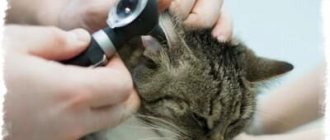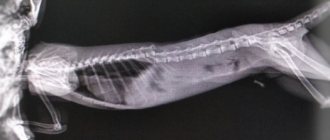5646Pavel
Cats are very active and playful animals, but despite their agility, they can suffer serious injuries under certain circumstances, and concussions are no exception. How to recognize the symptoms of a concussion in cats and provide the necessary first aid should be understood in order to prevent severe consequences of the injury in the future.
Possible causes of head injury
The active lifestyle of cats allows for various types of injuries. The well-known beliefs that cats always land on their feet and have 9 lives do not always work. A cat can get a concussion for many reasons, including a fall from a height, a head injury from a falling heavy object, a blow to a hard surface, or even beating from a person.
© shutterstock
Depending on the severity of the injury, circulatory disturbances, damage to the brainstem and hypothalamus, hemorrhage or tissue necrosis may occur in the brain, which in any case will affect the functioning of the central nervous system and the general condition of the pet. The most dangerous thing is that signs of a concussion in a cat may not appear immediately, but only after months or even years, when the process of pathological changes due to injury may no longer be reversible.
Causes of injury
A cat can get a concussion for a variety of reasons. The most common of them is falling from a great height . Despite their agility and ability to always land on their paws, which significantly softens the blow, cats do not know how to circumvent the laws of physics. When falling from a considerable height, they do not die, like other animals, but receive a severe blow, causing a concussion of the brain and spinal cord.
Unfortunately, it is often the person who causes the injury. It can be inflicted accidentally (a blow from a door being opened, a kick while walking) or deliberately. Not all people love these cute animals.
A cat can get a concussion by hitting an obstacle at high speed. This happens when an animal gets scared of something and rushes headlong away. At this moment, there may be an obstacle in its path that the cat, in a panic, does not notice.
Finally, these animals create trouble for themselves . While playing or exploring the surrounding area, animals can throw a heavy object onto themselves, the impact of which can cause a concussion.
Treatment
If your dog has a bad fall or accident and exhibits any of the above signs, it is very likely that he has a concussion. Now that you have identified the problem, you need to treat your concussion as quickly as possible. Just like humans, dogs also have a treatment protocol.
First, you need to calm your dog so that he doesn't get too excited. If she is scared or anxious, you will have a hard time determining whether she actually has a traumatic brain injury.
In some cases, your dog may not even be injured. You won't know until you calm him down and make sure he's okay. If there is a visible wound you should take your dog to the vet immediately. Even if there is no head injury, if your dog is showing symptoms, take him to the vet as well.
Since your dog may not report pain or confusion, in the event of a head injury, it's best to play it safe and take him to the hospital.
When it arrives, the veterinarian will run a series of tests on your dog. Basically, the veterinarian will draw blood and ensure that all of your dog's organs are working properly, eliminating the possibility of shock, before proceeding.
The shock is extremely severe and results in long-term damage and death. If you notice your dog is in shock, raise his head and watch his breathing in case he needs to perform CPR.
How to perform CPR on a dog:
- Lay the dog on its side on a flat surface.
- Place your hand on most of the dog's chest.
- With your arms secured, squeeze your dog's chest to a quarter of its width at a steady rate of 80 compressions per minute.
- Continue CPR until your dog is conscious, breathing on his own, or a trained veterinarian or staff can provide compressions.
Signs of shock are:
- Limited mental performance or activity
- blue gums
- irregular heartbeat
- low temperature
- rapid breathing
- shallow pulse
- convulsions
After ruling out shock and evaluating the heart and lungs, your veterinarian may give your dog oxygen and fluid infusions to prevent nausea and relieve some symptoms.
Your dog may also be prescribed some anti-inflammatory medications to reduce and prevent brain inflammation and to make your dog more comfortable.
Certain neurological tests may be performed to better assess the severity of a concussion. Some severe cases require surgery to correct brain bleeding or other internal injuries that accompany a concussion.
Like people who suffer a head injury, your dog will likely be kept overnight for observation. In severe cases, your dog may remain in the hospital for several days.
This time allows the veterinarian to determine how severe the brain swelling may be, rule out any type of internal bleeding, and closely monitor any symptoms that arise.
It also prevents secondary injuries, which can be more traumatic and cause more serious long-term consequences than the initial head injury. Other than these few steps, there really isn't much that can be done for a head injury. Observation and rest are key aspects of the healing process.
What happens when you get a head injury?
Falls from heights and blows to the head lead to disruption of the central nervous system of the animal. A severe concussion in a cat is equivalent to a brain contusion. That is, in a limited area of the brain, organ tissue is damaged. Along with the immediate impact zone, the brainstem and hypothalamus are affected.
Strong impacts cause destruction of brain tissue both at the site of impact and at the opposite wall of the skull. A concussion disrupts the functioning of vital centers. Blood circulation may be impaired. In severe cases, a severe concussion in a cat is accompanied by hemorrhages in the brain tissue and necrosis.
First signs
A dog that has suffered a concussion may behave normally with a minor injury. With more severe injuries, the following signs and symptoms of a dog concussion occur:
- Lethargy, inert behavior, apathy. These are usually the first signs of a mild concussion.
- Headache, due to which the animal either tries to keep its head unnaturally straight and still, or shakes it vigorously.
- Impaired coordination of movements.
- Nausea, vomiting.
- Lack of appetite.
- The dog sleeps a lot, tries to hide from everyone, even from its owners.
- Loss of consciousness, unexpected fainting. Loss of consciousness is especially dangerous if the animal is constantly vomiting - it can choke on its own vomit.
- Inappropriate behavior up to and including attacks on its owner and strangers.
- In severe cases, breathing and heartbeat disturbances occur, and the pupils are dilated over the entire eye and do not respond.
Spinal cord concussion in a cat
This injury most often occurs due to a fall from a great height. When the spinal cord is concussed in cats, the functioning of the pathways is disrupted, which causes problems with the functioning of any part of the organ. For example, if brain function is disrupted in the area of the cervical thickening, then the cat will experience paralysis of the limbs and parts of the internal organs. However, the animal will continue to live, so the brain will ensure the functioning of the lungs and heart. If a concussion of the spinal cord causes disruption of its functioning at the level of the 4th and 6th pairs of nerves , then the animal is likely to die, since this pathology will lead to paralysis of the respiratory center.
Forecast
The prognosis depends on the severity of the disease, the area of injury and its degree. Coma that lasts more than 48 hours or a progressive deterioration of the condition is considered to have a poor prognosis.
Cats who have suffered a TBI should be regularly examined by a neurologist to monitor the dynamics and correct the prescribed therapy. Some patients recover quite slowly and the extent of their recovery cannot be predicted
Neurological signs can persist in cats for almost months and it is important to be patient, follow all recommendations of a veterinarian, provide a high-quality diet and good care
Read reviews about our veterinary center. Call the number and schedule a consultation right now or request a call back. (c) Veterinary center for the treatment and rehabilitation of animals “Zoostatus”. Varshavskoe highway, 125 building 1.
Symptoms of Concussion in Cats
The most characteristic symptom for this injury is loss of consciousness immediately after the blow. The animal remains unconscious for several minutes, then comes to its senses. However, if there is a brain injury, the cat may fall into a coma. The severity of the concussion can be determined by the duration of unconsciousness. The longer the cat does not come to its senses, the more severe the injury and the more dangerous the consequences.
After the return of consciousness, the cat has poor spatial orientation for quite a long time. In some cases, memory loss may occur. The cat is afraid of the owner, does not recognize him, and can even show aggression.
You should contact your veterinarian immediately if your cat exhibits the following symptoms:
- The pupils have different sizes.
- The pupils react poorly or not at all to light.
- There are rapid, unpredictable movements of the pupils.
- A cloudy spot appeared on the pupil. The iris is shaking. This may indicate possible displacement of the lens due to ligament separation.
- Bruises were found on the head.
- The mucous membranes turned pale or, on the contrary, became excessively engorged with blood.
- The cat moves with an unsteady step.
- She has unmotivated attacks of aggression.
- Limbs twitch involuntarily.
- There is paralysis of the limbs.
- The cat is poorly oriented in the surrounding space.
- Breathing is intermittent, accompanied by wheezing.
It is important to understand that the intensity of symptoms depends on how severe the injury was to the animal. But this does not mean that if symptoms are mild, you do not need to take your cat to the veterinarian. It is necessary to consult a specialist in any case.
Treatment
It would be ideal if a dog’s concussion and its treatment are monitored by a veterinary specialist throughout the entire therapeutic course. The veterinarian assesses the animal’s condition and prescribes treatment based on personal observations and medical history from the owner of the four-legged patient. During the course, medications and their dosages can be replaced by one another, depending on the body’s response to the medication.
For a complete diagnosis it is recommended:
- take an X-ray of the skull to rule out fractures or splits of the cranial bones, as well as displacement of the cervical vertebrae;
- conduct a computed tomography scan to assess the extent of brain damage;
- Additionally, obtain advice from a veterinary ophthalmologist and neurologist.
Medications
Calcium chloride 10% Twice daily intravenously for 1-2 weeks, depending on the severity of the condition and the risk of developing cerebral edema. Manitol (Mannitol) 15% Administer slowly by drip (from 20 minutes to half an hour) at a rate of 0.25-2 g/kg daily for as many days as the situation requires, but at least 3 days. Furosemide 5% (diuretic) Intramuscularly from 0.5 to 2 ml 1-2 times a day for 3-5 days depending on the condition
Use caution if you have kidney problems.
Mexidol-Vet 2.5% Intravenously or into the muscle, 0.5 ml/kg during the first week, and then 0.25 ml/kg for another 2-3 weeks. Cerebrolysin 1 to 5 ml intramuscularly 1-2 times a day for at least a month. Piracetam Intramuscularly from 1 to 5 ml 1-2 times a day, depending on the severity of the condition. The course is at least 14 days. Cinnarizine ½ tablet
twice a day for a course of 1 month. Monitor the dynamics, the dose can be increased to 1 tablet in special conditions. Actovegin Intramuscularly, 1 ml 1-2 times a day for 1-3 weeks. The first week - daily, then every other day.
Papaverine Subcutaneously or intramuscularly 1-3 mg/kg twice a day or as required. Travmatin Subcutaneously or intramuscularly, 0.1 ml/kg, but not more than 4 ml at a time. Symptomatically. Baralgin 0.1 ml/kg intramuscularly in the morning and evening or on demand when the dog is clearly in pain.
Sereniya Subcutaneously at a dose of 0.5 ml/5 kg once a day and no longer than 5 days. Cerucal Intramuscularly (rarely subcutaneously) 0.2-0.4 mg/kg up to 4 times a day. Doesn't always help, because... There is individual sensitivity to vomiting of central action. Ondasetron 0.5 mg/kg intramuscularly or intravenously no more than 2 times a day for 3-5 days.
| Lauretin S | Subcutaneously or intramuscularly by slow injection |
| Sulfocamphocaine | No more than 2 ml at a time per animal, depending on the size and severity of the condition. Subcutaneously, intramuscularly or slowly intravenously. Symptomatically. |
| Cordiamine | Dose: 0.2-0.5 ml subcutaneously per individual if necessary. |
| Caffeine-vet 20% | 0.2-0.5 ml subcutaneously per animal symptomatically if necessary. |
| Vetspokoin | Orally (into the mouth) 1 ml/10 kg for small dogs and 1 ml/20 ml for large dogs twice a day for 15 days. |
| Clonazepam | 0.06-026 mg/kg orally twice daily. It should not be abused, it is addictive. Slow “acceleration” of action. |
| Seduxen | 1.5 to 3 mg orally or intramuscularly symptomatically to calm very aggressive dogs. |
| Spitomin | Suitable for long courses - from 4 to 6 weeks. The dosage is selected individually, starting from 0.6 mg/kg (maximum 1 mg/kg) twice a day. |
| Valium (diazepam) | 0.017-0.07 mg/kg orally up to 3 times a day. Do not take for a long time, it provokes physical addiction. Aggressive dogs are not allowed, because... blocks inhibition reflexes, the dog may bite unconsciously. |
| Vitam | Intramuscularly or subcutaneously from 1 to 5 ml 1 time in 3 days for 2 weeks or daily for 1 week - depends on the general condition and appetite. |
| Gamavit | Subcutaneously or into the thigh at a dose of 0.1-0.15 ml/kg once a day every other day for 2-4 weeks. |
| Glycopene | Orally 0.1-0.15 mg/kg (1/2-2 tablets) once a day for a week, daily or every other day. |
| Neurobex | ½ tablet 1 r./day for 1 month. |
Symptoms of spinal cord concussion in cats
With a mild injury, when the substance of the spinal cord remains intact, the cat may experience short-term paralysis of the limbs. In severe injuries with vertebral cracks and ruptures of the spinal cord membranes, signs of total paralysis are observed. Sensitivity of the limbs and tail is reduced to a minimum. The rectum may fall out.
With a severe concussion of the spinal cord, the cat will move only on its forelimbs for some time. The hind limbs, although they retain sensitivity, do not obey brain signals . If left untreated, it is likely that the hind limbs will remain paralyzed, and a hump will grow at the site of the spinal cord damage. This is if the animal survives.
Initial activities
MRI, CT (if available);
X-ray of the chest, skull in two projections, cervical spine; IMPORTANT! Every tenth patient with severe TBI also has damage to the cervical spine. Until spinal injury is ruled out, the animal should be managed as having a spinal injury.
Laboratory tests: complete blood count, blood glucose, blood gases and electrolytes, creatinine and blood urea, complete urinalysis; monitoring: general clinical – blood pressure, heart rate, respiratory rate, ECG, blood saturation; neuromonitoring – ICP, EEG, transcranial Doppler echography.
First aid for a cat with a concussion
In the case where the injury was caused by a strong blow to the head, you need to take the cat and bring it into a room with fresh air and dim lighting. If the animal is unconscious, then you need to do the following:
- Lay the cat on its side.
- Make sure your pet's tongue is not stuck.
- Apply a cold compress to the impact site. An ordinary towel soaked in water can play its role.
- If there is an open wound, then it must be covered with a bandage, after stopping the bleeding.
- When vomiting begins, you need to do everything to prevent the cat from choking.
- If the cat has stopped breathing, you will need to perform artificial respiration and massage the heart area.
Before the veterinarian arrives, it is allowed to give the injured pet an injection of caffeine , but it is still better not to try to treat it yourself.
Do not forget that after a concussion the cat will be in a state of shock for several days. At this time, she may not recognize her owners and treats them aggressively. Therefore, you need to be patient.
If the cat still does not regain consciousness, and there is no way to call a veterinarian, then the pet should be transported for examination by a specialist on its side. However, the animal should not be placed in a carrier. It is better to transport the cat in your arms.
Traumatic shock
Traumatic shock is considered one of the most dangerous conditions in cats. It is the most common cause of death in animals.
Signs of traumatic shock
Shock in a cat can be determined by the following signs:
- change in heartbeat (increased or slowed down);
- breathing became faster;
- gums become pale (may become completely white);
- body temperature has decreased.
If you find no external damage to your pet, shock may be caused by bleeding or internal damage.
First aid for a cat with traumatic shock
An injured cat needs immediate help. To begin, place the cat on its side on a pre-spread towel (or diaper). If necessary, open its airways: place your palm under the animal's head so that the index finger and thumb are above its upper fangs. Then tilt your head lying on your palm so that the animal’s nose is directed upward. Squeeze your fingers very gently, after which the cat’s mouth will open slightly. Gently pull your pet's tongue with your other hand, thereby opening the airway.
Place a rolled-up towel or small pillow under the cat's hind legs and hips - the back of the cat's body should be elevated.
Carefully examine the animal, if you find external bleeding, stop it.
Diagnostic methods in the clinic
What will need to be done to diagnose the cat's condition at the veterinary clinic will depend on the severity and nature of the injuries.
The veterinarian will examine the animal, measure basic vital signs, assess the patient’s general condition, and whether the pet’s life is currently in danger. In any case, even in the absence of visible injuries, an X-ray examination will be necessary: it will help assess the condition of the bones and respiratory system (presence of pneumothorax, pulmonary edema, etc.).
Ultrasound examination (ultrasound) is also performed to assess the condition of internal organs. Further diagnosis will depend on the presence, nature and severity of specific injuries.










